Red Rocket
This aircraft was built as part of the “Imperial German Air Service / Luftwaffe Group Build May 1st, 1910, to Present Day” group build.
Maj. Wolfgang Spate was the commanding officer of EKdo 16 (Erprobungskommando 16 or Test Command 16).
He was an experienced fighter pilot with, at the time, 79 victories scored while with JG 54. Pre-war Spate had been an accomplished and award winning glider pilot. These two attributes made him the ideal person to be charged with bringing the Me 163 Komet, a rocket powered interceptor that returned to base as an unpowered glider, into operational service.
At around midday on the 14th of May, 1944, with a US bombing raid on its way to bomb the Reich, Spate walked out to the flight line to undertake the first operational flight of the Me 163.
To his dismay, what greeted him was a "tomato-red" Me 163B. The ground crew had secretly painted the aircraft over night to celebrate the first combat flight of the type and adding around 18 kg (40 lb) of weight to the aircraft in the process.
Although he was not too happy with the colour, which wasn't "going to frighten the enemy", he climbed in the cockpit and prepared to take off. "If I roared past an enemy aircraft in this get-up at 700 km/h in a steep climb, some naive individual might think that I was a phantom from outer space. But when I tried to make it back to the airfield, gliding without a drop of fuel left, I would be easy to see from miles away...".
Taking off, Spate climbed steeply at 700 km/h, straining to see the American bombers but with out any luck. Then he spotted two pairs of P-47s and prepared to attack the rear-most aircraft. While manoeuvering into position his engine cut out - probably due to a small amount of negative g when he pushed the nose down. Rather than abort, Spate decided to try and re-start the engine while the P-47s slowly pulled away, completely oblivious to the bright red rocket on their tails.
After waiting the required 2 minutes Spate was able to restart the engine and catch-up with the enemy. As he drew to within firing range a force like "an overpowering fist was pushing down on my left wing. I applied counter pressure to control it. It didn't respond. Just the opposite, now the nose was going down, too.". Checking his air speed indicator he saw it was reading 960 km/h. His aircraft was suffering from the onset of compressibility at around M0.86.
Spate was forced to abort the mission and return to base.
He ordered the aircraft to be repainted.
In mid-May 1944 Spate took over command of IV/JG 54 in the East and gained his 90th victory. In September IV/JG 54 transferred west where he gained another three victories.
In December he was reunited with the Me 163 when he took command of JG 400 until it was disbanded in March 1945. From there he was the appointed commander of III/JG 7 where he gained another five victories flying the Me 262. In total he flew nearly 600 missions to score 99 victories, 90 of them on the Eastern Front.
There is not much to this build as it contains relatively few parts.
It had already been started when I purchased the kit and the wings and a few other parts were already assembled.
I painted the cockpit and RLM 66 and hand painted the dials on the instrument panel. Then I placed it in between the upper and lower fuselage halves and attached the tail halves. The fuselage/tail join required a bit of blending.
The nose is the weakest part of this kit as it needs to faired into the fuselage with putty, otherwise there is a waisted effect at the join.
One advantage of having built the Trimaster version of this kit (the plastic and etch parts are identical, but the original white metal parts have been rendered in plastic for this kit) is that I still have the instructions. One of the options in the Trimaster kit was the V41, so the instructions include the small details required to model that aircraft. The necessary parts are present but marked as not for use.
Early Me 163s had small fairings over the vents each side of the rocket nozzle. The tail had been assembled by the previous owner, but I was able to locate and drill out the holes required to mount these parts.
A second difference is that early aircraft had the tail wheel assembly with the fairing, so that was a simple addition.
Lastly, the Me 163B-0 were armed with 20mm MG 151/20 canon, the long barrels of which protruded quite a way out from the wing roots. The 30mm MK 108s of the later Me 163B-1a were hidden inside the wingroots and therefore not visible. After paining, I added these gun barrels using brass tubing.
I also replaced the very flimsy kit pitot with fine brass rod.
The canopy parts were attached and masked ready for painting.
This is obviously a simple, single colour scheme.
As the real aircraft was painted over night prior to the types first mission it would have been a hurried job. So, I pre-shaded with RLM 66 that I used to paint the canopy frame, representing the interior colour and then sprayed an undercoat of the RLM 76 (Pale Blue). The reason I chose the latter colour was because photos of other pre-production aircraft show them to be in a single, light colour, either RLM 02 or RLM 76.
Next, I sprayed the RLM 23 Red, being careful to leave the various undersurface nooks and crannies the pale blue to reflect the hast with which the real aircraft would have been painted.
As this aircraft was a hasty repaint, it would have had minimal stenciling visible. I kept the T- and C-Stoff markings and, to add a little interest, I kept the small circular access panel in the lower port nose the original RLM 76. On production aircraft this panel had a coloured ring and text around it, but on the second, early build, aircraft on the Trimaster instructions, this panel had a simple two row stencil, so I used this decal.
The Kagero book includes decals for the stammkennzeichen (radio codes) on the fuselage, but these were the wrong font and a little oversized, so I used the Trimaster decals, but was careful to trim as much of the clear film as I could to minimise the potential for silvering. I decided against adding these under the wings as I'm not sure if they would have been used.
I used the kit wing and fuselage crosses, also trimmed of clear film, but sourced a swastika from an old Superscale sheet.
I've wanted to build this particular aircraft ever since I read Spate's biography and it makes a colourful companion to the Mitsubishi J8M I recently built and the much older Me 163B-1.
At $10 it was well worth the money.
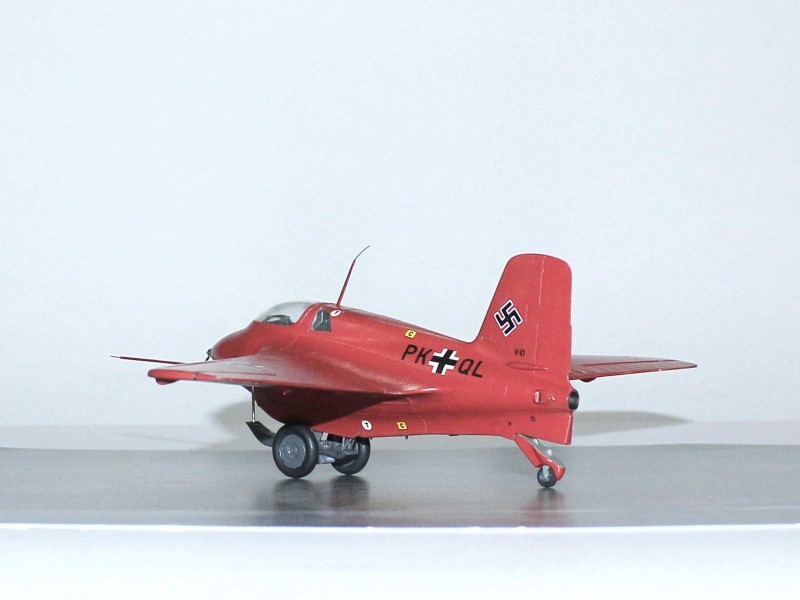
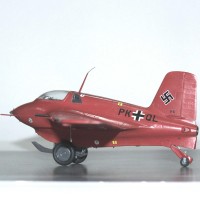


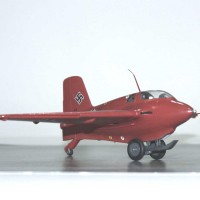
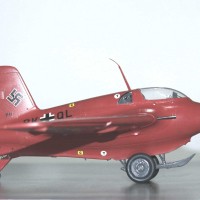
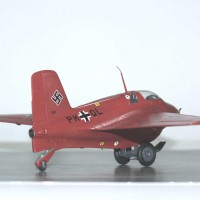
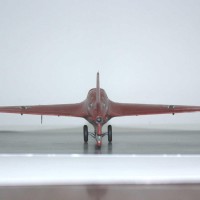


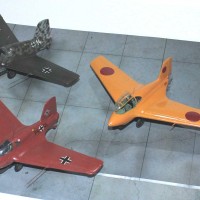
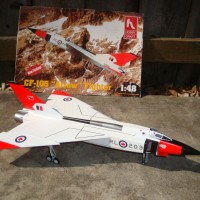
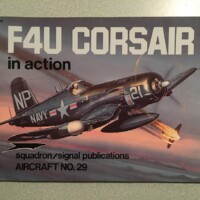
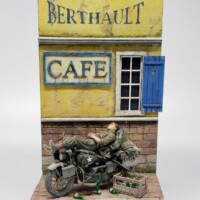
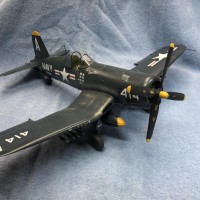
Nice work, @michaelt. I think the DML/Dragon Me-163 is the best kit of this airplane, and you've created an excellent result here for a "rescue" model.
Beautiful build, Michael! The final red shade really captures the looks of the real thing, as can be envisaged by the story behind it! The story of Maj. Wolfgang Spate and his red Komet was really fascinating!
Thanks for contributing in our wonderful "German air Service/Luftwaffe" GB!
P.S. love the last "collection" pic...
Very nice build, Michael @michaelt
Thanks for sharing Spate's biography as well, very interesting to read.
Great work, Michael (@michaelt). I have always liked this striking scheme on the 163. Great group photo at the end.
Beautiful result Michael! That kit is miles ahead of the old ex-Hawk, Testors Komet I've built (btw, in the same paint scheme). That's great looking little model! 🙂
Hee hee! The great thing about this forum (apart from the kits) are the stories like this one!
Nice work!
Very nice trio you have there Michael@michaelt . Thanks for the info Spate.
An excellent example of this model, and I always enjoy reading the story, definitely liked.
Good looking addition to your rocket collection. Well done!
Well done Michael, nice history lesson and bio of Spate as well.